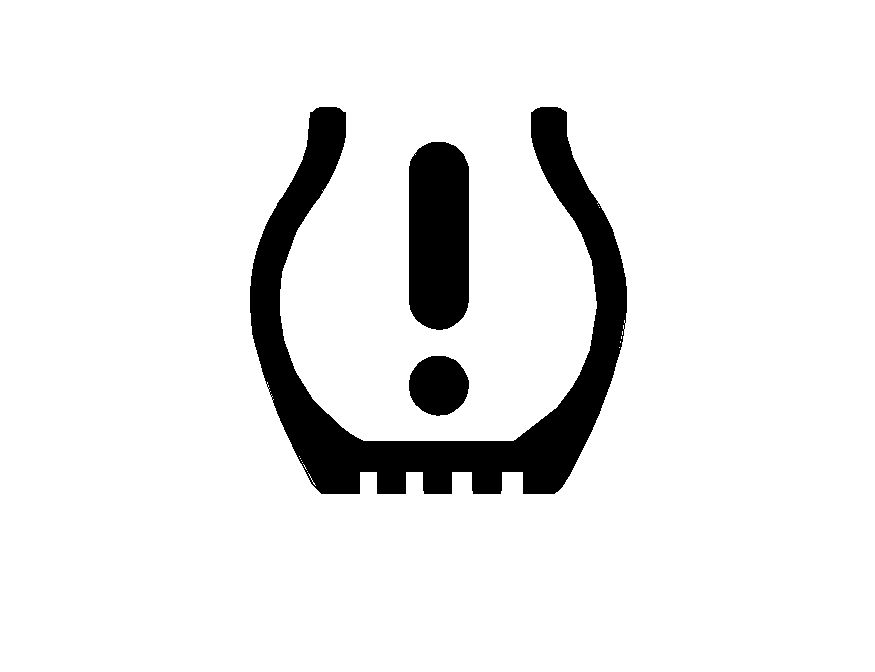The Tire Pressure Monitor System (TPMS) is designed to warn the driver when a low tire pressure condition exists. TPMS sensors are mounted onto each tire and wheel assembly, excluding the spare tire and wheel assembly. The TPMS sensors monitor the air pressure in the vehicle's tires and transmits the tire pressure readings to a receiver located in the vehicle.

When a low tire pressure condition is detected, the TPMS illuminates the low tire pressure warning light located on the instrument panel cluster.
This light also comes on for a few seconds and then goes off when you turn the ignition to ON/RUN. This indicates the TPMS is functioning properly. If the low-tire pressure warning light comes on while driving your vehicle, the system may have detected a low-tire condition. You need to stop as soon as possible and check the tires.
The low tire pressure warning light may come on in cool weather when the vehicle is first started, and then turn off as you start to drive. This could be an early indicator that the air pressure in the tire(s) are getting low and need to be inflated to the proper pressure.
A Tire and Loading Information label, attached to your vehicle, shows the size of your vehicle's original equipment tires and the correct inflation pressure for your vehicle's tires when they are cold. See Loading the Vehicle , for an example of the Tire and Loading Information label and its location on your vehicle. Also see Inflation - Tire Pressure .
Your vehicle's TPMS can warn you about a low tire pressure condition but it does not replace normal tire maintenance. See Tire Inspection and Rotation and Tires .
TPMS Malfunction Light
The TPMS will not function properly if one or more of the TPMS sensors are missing or inoperable. When the system detects a malfunction, the low tire warning light flashes for about one minute and then stays on for the remainder of the ignition cycle. The low tire warning light comes on at each ignition cycle until the problem is corrected. Some of the conditions that can cause the malfunction light to come on are:
| • | One of the road tires has been replaced with the spare tire. The spare tire does not have a TPMS sensor. The TPMS malfunction light and DIC message should go off once you re-install the road tire containing the TPMS sensor. |
| • | The initialization (reset) procedure was not performed correctly after replacing or rotating tires or wheels. See "TPMS Reset" later in this section. |
| • | One or more TPMS sensors are missing or damaged. The DIC message and the TPMS malfunction light should go off when the TPMS sensors are installed and the sensor matching process is performed successfully. See your dealer/retailer for service. |
| • | Replacement tires or wheels do not match your vehicle's original equipment tires or wheels. Tires and wheels other than those recommended for your vehicle could prevent the TPMS from functioning properly. See Buying New Tires . |
| • | Operating electronic devices or being near facilities using radio wave frequencies similar to the TPMS could cause the TPMS sensors to malfunction. |
| • | If tire chains are installed on the vehicle. |
| • | If there is a lot of snow or ice around the wheels or wheel housings. |
| • | If a window tint that affects the radio wave signals is installed. |
If the TPMS is not functioning it cannot detect or signal a low tire condition. See your dealer/retailer for service if the TPMS malfunction light comes on and stays on.
TPMS Reset
In order for the tire pressure monitoring system to work properly you need to reset (initialize) the tire pressure monitoring system. Any time you repair or replace a tire or wheel, or rotate the tires the tire pressure monitor system needs to be reset.
Do not reset (initialize) the system without first correcting the cause of the low-tire condition. If the system is reset when the tire pressures are incorrect, the system will not function properly and might not alert you when a tire is low.
When initializing the system, the present tire inflation pressure is stored as standard. The tire pressure warning system determines decreased air pressure by comparing the present and the standard tire inflation pressures. When you change the set tire inflation pressure, it is necessary to initialize the tire pressure warning system.
To reset (initialize) the system:
- Park the vehicle at a safe place and apply the parking brake. Turn the engine off.
- Turn the ignition to ACC/ACCESSORY or LOCK/OFF.
- Adjust the tire pressure of all the installed tires to the specified cold tire inflation pressure level.
- Turn the ignition to ON/RUN with the engine off.
- Wait for a few minutes with the ignition in ON/RUN, and then turn the ignition to ACC/ACCESSORY or LOCK/OFF.

Press and hold the tire pressure warning reset switch until the tire pressure warning light flashes slowly on/off three times.
If the low-tire pressure warning light does not flash three times while you press and hold the reset button, the reset has failed. Repeat the reset process. If the reset cannot be performed, see your dealer/retailer for service.
If you press the tire pressure reset switch while the vehicle is moving, the reset is not performed. If you press the tire pressure reset switch accidentally and initialization is performed, adjust the tire pressure to the specified level and initialize the system again.
